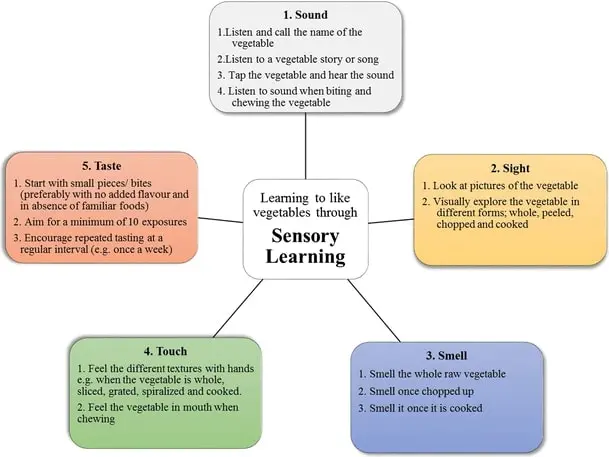settings
children
With Famly since
Do you remember the first time you ate an apple? Or a spoonful of yogurt? Chances are – you probably don’t. But the foods we’re exposed to in the Early years have a much bigger impact than you might think.
Getting children to develop healthy eating habits is tough – especially when you’re experiencing fussy eating. It’s easy to get frustrated, but sensory cues are the key to getting children to develop healthy, happy and positive eating habits in later life.
How well foods go down isn’t a short journey – it begins from weaning up until around 3 – 4 years old when children start to decide what they love and what they loathe. That’s why it’s important to make the most of the first few years – once eating behaviours set in they follow us into adulthood.
Giving children a multi-sensory learning experience has been shown to work wonders – as to tackle food rejection we should look at food play in a whole new light. Let’s take a look at why children reject foods, and the ways you can help them let go of the fear of the unknown and encourage inquisitive eating habits.

Food Rejection
It’s actually a myth that infants prefer certain foods – they have very few preferences and are keen to try new things. However, the environment and choice of food offered plays a huge role in children’s eating habits.
Meal times can be stressful. Children are often put under pressure when they eat too little or too much, and offered dessert as a reward. It’s natural to get frustrated when children won’t eat new foods, but your reaction to their rejection is vital. If children sense your frustration, this pressure alone can be very overwhelming.
Before we dive into the reasons why children reject foods and the reasons behind it, it’s worth keeping the two points below in mind:
- Make sure that you have a calm and relaxed eating environment. Try not to be rushed or stressed. If children are relaxed and focused on the food in front of them, they’ll be more likely to try new things. Too many distractions can act as a sensory overload, so they need a sense of calm.
- Approach the learning process with an open mind and be ready to try alternative methods. It can take a few attempts before a child accepts a food – don’t give up at the first hurdle.
Tackling sensory issues
If children have sensory issues, trying new foods can be traumatic. Let’s be honest, you might be a little apprehensive when you try something new, too.
Often, food rejection is about the way it feels or smells. Children can become stressed out by this, meaning they associate that new food with fear. The sooner we can tackle this, the better, as this fear leads to only sticking to food that’s familiar.
How to tackle this unfamiliarity? Exposure! Give them lots and lots of opportunities to try new things.
Top tips for children who might be overwhelmed:
- If you’re struggling, try foods that are similar in texture and taste to what the child is happy to eat – they’re more likely to be accepted.
- Many of us growing up were told not to play with our food. As it turns out, allowing a child to play with their food can reduce stress and allow exposure: if a child is happy to touch a food, they may be happy to eat it.
Understanding the Sensory Journey
I’ve broken down the way children experience and accept food through sound, sight, smell, touch and taste. But first it’s important to know how a child interacts with the food in front of them in order to use all five senses.
Let’s look at Sue Gascoyne’s example of how a child eats an ice cream:
- Analysis – tasting
- Action – licking
- Feedback – likes the strawberry bits
- Action – more licking
Understanding the way children approach food helps us introduce new foods, as we have to realise that it’s a process – it’s not immediate. Taking a creative approach to food that involves all five senses is ideal for minimising issues such as fussy eating as much as possible.

Sound and Sight
Reading stories and looking at picture books are fantastic ways for children to absorb new knowledge, and get them used to how food looks and the names we give them.
A study showed children aged 19-26 months who were read a storybook every day for two weeks were far more likely to eat foods they had been exposed to in books than foods they hadn’t. The simple act of exposure worked magic on their willingness to taste new flavours.
This visual and oral strategy can be an extra activity outside of mealtimes when the stress of getting a child to eat can be problematic. This worked particularly well when children were involved in the story and actively asked questions, as this boosted their engagement. The more interactive, the better!
Give food a place outside of mealtimes – reading picture books about food before bed, for example. Letting children familiarise themselves with foods in different formats plays a huge role in their willingness to stray from the foods they’ve decided are ‘safe’.
Smell
The way food smells is more important than you might think. Did you know that introducing different smells increases the chance of children tasting new foods? The smell of bananas and pizza have been proven to make adults hungrier, and, although nothing has been proven, this phenomenon probably affects little ones too.
Top tips:
- Introduce how fruit and vegetables smell in different ways. They’ll smell completely different if they’ve been cooked, and if they’re completely raw.
- Play games associated with smells and foods and get children to use their noses! Put coffee, lavender, vanilla and fruit teas into ‘scent bags’ to see what reactions they create. As children get older, these can be guessing games and then incorporated into stories. Treasure baskets work really well with younger ones. They can investigate a variety of household items, some foods, some not, and explore their different smells and textures. Try pricking oranges and lemons to allow the scents to escape, as well as fresh herbs, celery, or gingerbread men.
Touch
The texture of a food can be the deciding factor on whether it’s eaten or not. Some textures will appeal, and others will be met with absolute refusal. Food is more likely to be accepted if it’s familiar, but it can be difficult to introduce foods if the child really dislikes a certain texture.
Playing with food actually has a very positive effect on eating habits. In one study, when children were given jelly to play with as an activity, they were far more likely to eat it when offered it as a dessert option. Simply playing and touching the food beforehand has incredible potential to help children understand and explore new textures.
Top tips:
- During weaning, finger foods are a perfect way to explore texture. Mix it up by offering the food all its forms: grated, sliced, peeled, and cooked.
- Be creative with the same foods. There’s no need to give up on carrots altogether if they aren’t going down a treat. They might not like cooked carrots, but what about raw carrots in a hummus dip? Broccoli could be preferred roasted to boiled. Always explore alternative, creative options.

Taste
Children are at a sensory high around the 6 months mark when they’re being weaned. This makes it the ideal time to start introducing new and exciting flavours for them.
The flavours you introduce have a long-lasting effect on future likes and dislikes, which is why repetition is absolutely crucial at this point. This 2007 study tried this method with green beans. Children between 4 – 8 months were three times more likely to eat green beans after 8 days of exposure to them. Repetition and exposure are absolutely key!
Top tips:
- Cut food up into small pieces – ideally fruit – and allow the children to taste them one at a time and see what kind of reaction you get.
- Aim for a minimum of ten exposures, and repeat the process regularly so that the child becomes familiar with the new taste.
Why your response matters
I always used to tell my children: “Don’t play with your food!” Now, as a nutritionist asking childcare professionals about sensory learning and food play, I hear the same thing.
We’ve been taught that playing with food leads to bad manners. There are also concerns over food waste and how food play can be a sign of our society’s deteriorating relationship with food.
Whilst aware of these issues, childcare respondents were adamant that children need to play and stimulate their sensory organs at an early age. Children will want to play with food anyway, so enabling them to do so in a safe environment to empower their learning is more productive for everyone. As one early years professional said, “educating them about waste and caring for those that do not have comes after they fully have learnt from their basic sensory personal experiences.”
Sensory learning is an investment. Allowing children to be tactile and play with their food in a way that promotes a healthier, more open relationship with food reduces the likelihood of food rejection and wasted meals in the future.
The big ideas
Try learning journals for free
Add observations, and build digital learning journals to share with families instantly. All with your completely free 14-day trial.
Get started









